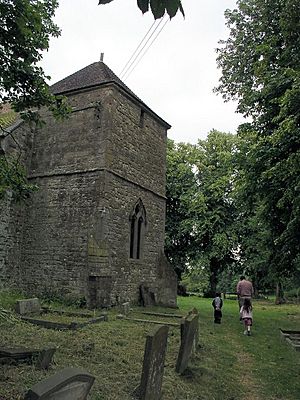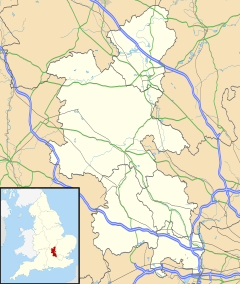Water Stratford facts for kids
Quick facts for kids Water Stratford |
|
|---|---|
 Tower of St Giles' parish church |
|
| Population | 112 (2011 Census) |
| OS grid reference | SP6534 |
| Civil parish |
|
| Unitary authority |
|
| Ceremonial county | |
| Region | |
| Country | England |
| Sovereign state | United Kingdom |
| Post town | Buckingham |
| Postcode district | MK18 |
| Dialling code | 01280 |
| Police | Thames Valley |
| Fire | Buckinghamshire |
| Ambulance | South Central |
| EU Parliament | South East England |
| UK Parliament |
|
| Website | Water Stratford village website |
Water Stratford is a small village and civil parish located by the River Great Ouse in Buckinghamshire, England. It is about 3 miles (5 km) west of Buckingham town, close to the border with Oxfordshire.
Contents
The Name of Water Stratford
The name "Stratford" is quite common in England. It comes from an old English phrase meaning "ford by a Roman road". A Roman road is still visible through the village today! The word "Water" was added to the name to help people tell this village apart from other places called Stratford.
Over many centuries, the village's name changed a few times:
- In 1086, it was called Stradford in the Domesday Book.
- Later, in the 1200s to 1400s, it was known as Stratforwe, Straford, and Westratforde.
Water Stratford's History
The first known mention of Water Stratford was during the time of Edward the Confessor, who was King of England from 1042 to 1066.
After the Norman conquest of England in 1066, William the Conqueror gave many lands, including Water Stratford, to a powerful Norman lord named Robert D'Oyly. He was the person who built Oxford Castle.
The Domesday Book of 1086, which was a big survey of England, recorded that Water Stratford had enough land for farming that was equal to eight "hides". A hide was an old English way to measure land.
The D'Oyly family owned Water Stratford until the 1200s. Then, it passed to other important families through marriages and exchanges of land. For a long time, the manor (the main estate) of Water Stratford belonged to the Prince of Wales. This continued until the English Civil War in the mid-1600s. After 1650, there are no more records of who the main feudal lord was.
The current manor house in Water Stratford has a stone that shows it was built in 1598. Parts of its staircase are from the early 1600s. Other parts of the house were updated in the 1900s.
The Domesday Book also mentioned that Water Stratford had a watermill by 1086, probably on the River Great Ouse. This mill was later destroyed in 1349.
Saint Giles' Church
The Church of England parish church in Water Stratford is called Saint Giles. It was first built in the 1100s.
- The south doorway of the church is in the Norman style and has a beautifully carved stone archway called a tympanum. This carving shows Christ in Majesty.
- The arch leading to the chancel (the area around the altar) and two narrow windows in the chancel are from the 1200s.
- The church tower was built in the 1300s. Over the years, more windows were added in the Decorated Gothic and Perpendicular Gothic styles.
- In the 1700s, the tower was made shorter.
- The church was almost completely rebuilt in 1828. What's special is that its original old features were carefully kept and put back in their places.
- The tower has three bells.
- St. Giles' Church is a very important historical building and is listed as a Grade I listed building.
Famous People from Water Stratford
Water Stratford has been home to some interesting people:
John Mason (1645–1694)
John Mason was the priest of St. Giles' Church. He was a Puritan, a type of Protestant Christian, and was respected by other religious leaders. Mason wrote over 30 hymns, including the well-known "How shall I sing that majesty".
Towards the end of his life, John Mason's health declined. From 1690, he began to preach that the Second Coming of Christ (when Jesus returns to Earth) was going to happen very soon. He also believed he was the prophet Elijah and that he would come back to life three days after he died.
From 1693, hundreds of his followers came to Water Stratford. They stayed in barns or camped in fields, waiting for the Second Coming. Mason died on May 22, 1694. His followers believed so strongly in his words that the new priest had Mason's body dug up to show them he had not risen. Even then, some followers stayed in Water Stratford for up to 15 years, still waiting, until they were eventually asked to leave by the local authorities.
Joseph Bosworth (1788–1876)
Joseph Bosworth was a scholar who studied Old English. He wrote the very first dictionary for Anglo-Saxon (an old form of English). He was also a professor at the University of Oxford. From 1858, he was the priest of St. Giles' Church in Water Stratford.
Other Notable Residents
More recently, some famous people who lived in Water Stratford include:
- Paul Daniels, a well-known magician.
- Peter Woodthorpe, an actor.
- Yana (singer), whose real name was Pamela Guard, a singer.


